Using mini-neodymium (rare earth) magnets for miniatures bases.

I have written briefly about the use of magnets that I do for my 25mm minis but the details are not all clear, so I shall now try to explain it all.
 My first thoughts about using the magnets were to 'glue' the magnets to regular wooden movement bases (using cyanoacrilate or super-glue). I did it with the first 50 or so bases and then covered the entire base with my normal flocking materials. It was difficult and messy, since the magnets are so strong I had to attach them in stages, otherwise they would 'jump' onto one another and the glue would stick them that way permanently. I did end up with one stack of two magnets that I could not separate fast enough, though only one in about 500 magnets was pretty good I thought.
My first thoughts about using the magnets were to 'glue' the magnets to regular wooden movement bases (using cyanoacrilate or super-glue). I did it with the first 50 or so bases and then covered the entire base with my normal flocking materials. It was difficult and messy, since the magnets are so strong I had to attach them in stages, otherwise they would 'jump' onto one another and the glue would stick them that way permanently. I did end up with one stack of two magnets that I could not separate fast enough, though only one in about 500 magnets was pretty good I thought.These first ones I still use from time-to time, mainly whenever the battles are really large, since I have switched to a new system.
I decided that the wooden bases were not 'flexible' enough, since the magnets were permanently attached. So I set on a new plan, sheet metal bases in 20 gauge satin coat steel.



This is really the best part, I had decided that I wanted the system to also allow for the 'commands' and 'unit designations' to be visible to players while on the tabletop. The basic concept comes from the Napoleons' Battles game "Introduction to miniatures games", in this they suggest the 'tags' system using a sheet of paper tags that get taped to the bottom of the movement stand and 'bent' up showing the relevant game data. Essentially just unit designation data, since the 15mm minis bases are so small.
In order to get this 'bent' tag I decided to have 300 small 60-degree (thus two sides of a triangle) "L-shaped" 1 inch wide brackets made of the same sheet steel. The cost for the tags was very high compared to the flat small shapes, but what a difference they make!
I can now identify any unit in any way, what I do before the battle is print off, on magnetic paper, all the units (in the samples here) identification, battle numbers, movement figures, and for commanders - even a small actual picture of the historical commander!

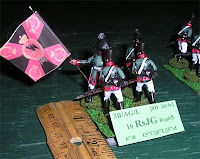
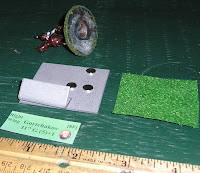
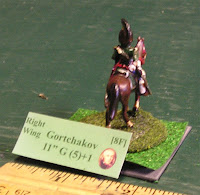
The magnets are more than powerful enough to hold a single 25mm man sized mini, in the case of cavalry, I use two magnets, for artillery and commanders three. All of my minis have steel 'fender washers' under them. I have been doing this part for years, ever since the Star Wars Miniatures Battles System (1991) suggested doing this for 'stability' and to mark the 'reach' for contact purposes in man-to-man games. The metal and magnets are covered in simple grass paper, I am still using up an old grass paper mat that I first got to cover my table with. In the future I am planning to make some very textured newer stand covers for the men to march on. To date only sun fading has been a problem and no 'friction' marks can be seen on any of the grass paper covers.
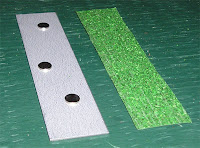

I am now seeing more possibilities for the minis mounted this way, as all I need to do in order to switch game systems (for those with different basing systems) is to get more metal bases that match the different system's size. For skirmish games I am already set as all I need to do is 'not' use the bases and let the minis march separately.

 I have also just used another larger fender washer and some grass paper mat cut to the right size for a command 'marker' flag that Bluebear Jeff's Tricorne Wars rules calls for.
I have also just used another larger fender washer and some grass paper mat cut to the right size for a command 'marker' flag that Bluebear Jeff's Tricorne Wars rules calls for.Other possibilities are starting to come to light now, with Naval actions becoming visible on my horizon I am looking into systems that will integrate these magnets and metal bases so that the 'book-keeping' of many naval rules systems all takes place ON THE MINIATURE ship/base-stand and, if possible, there will be no paperwork at all for the active players. More on this later....
Remember all you need do is clik on a pic to see it larger!
Cheers
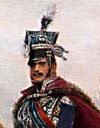





















































4 comments:
Now that's ingenious!
Good article.
I had the same problem with one magnet jumping to another and sticking permanently, once.
Overall, though, I like the flexibility of basing options for different games or skirmish vs. battles or vignettes/dioramas.
Murdock, I'm glad that you've finally posted more information on this.
One suggestion, since there are so very many sizes of these neodymium magnets, please let us know what your favorite magnet size is (and what might be too small).
-- Jeff
Yes Jeff,
I have a second part in mind when doing this article, with some comments about magnet sizes etc as well as some 'lower cost' ideas.
Must do Daddy daycare today, then perhaps get the graphics done for the sample ideas.
At least I have been doing some painting during the daddy daycare times now...
Post a Comment